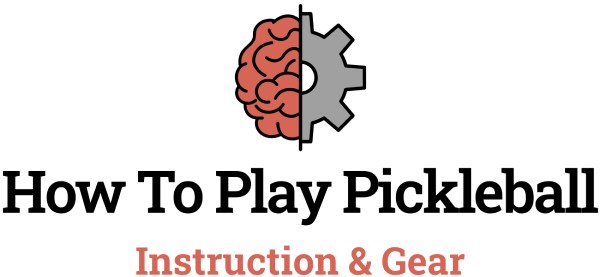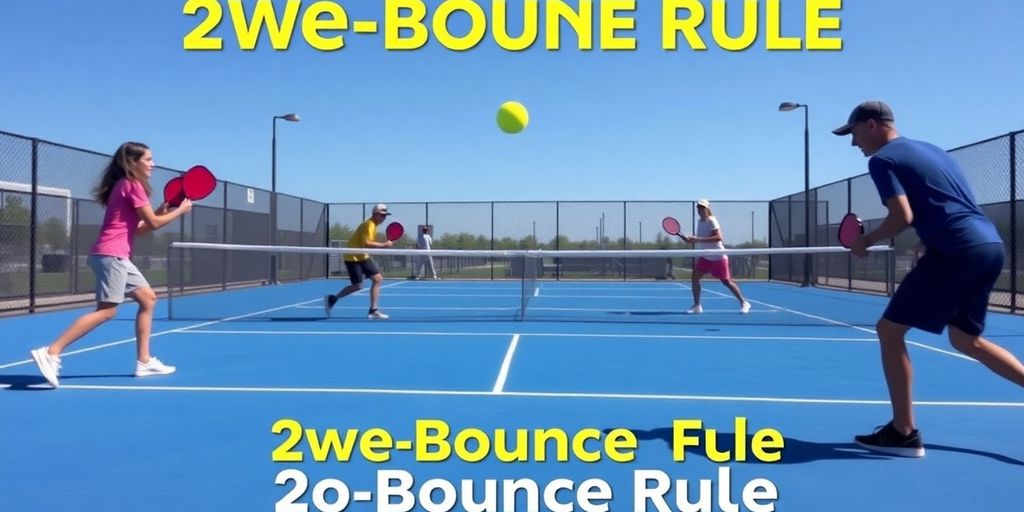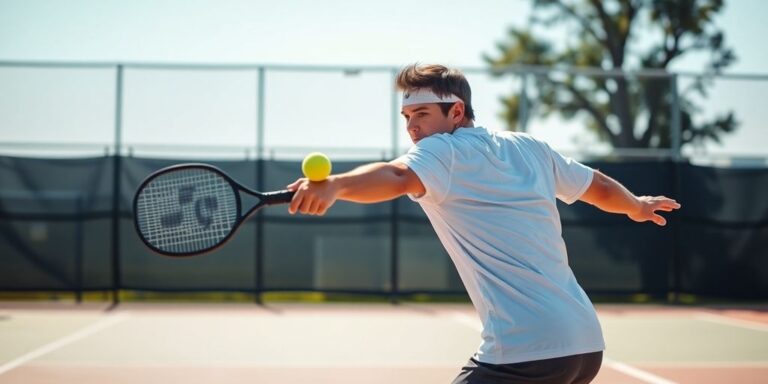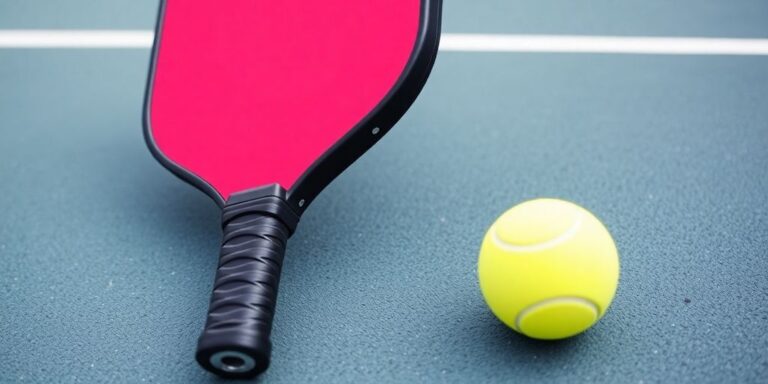If you’ve ever played pickleball or watched a game, you might have heard about the two-bounce rule. This rule is pretty important for how the game is played, and it can be a bit confusing for newcomers. In this article, we’ll break down what the two-bounce rule is, how it works, and why it matters. We’ll also clear up some common misunderstandings and give you tips on how to apply this rule in your games. So, whether you’re just starting out or you’ve been playing for a while, there’s something here for you to learn about how many bounces in pickleball.
Key Takeaways
- The two-bounce rule requires the ball to bounce once on each side after a serve before hitting it back.
- Understanding the difference between the two-bounce rule and the double bounce rule is crucial for players.
- This rule helps create longer rallies and a more balanced game.
- The two-bounce rule originated to level the playing field and prevent serve-and-volley advantages.
- Clarifying the terminology around bounces can help new players feel more confident on the court.
Differentiating Between The Two-Bounce Rule And Pickleball Double Bounce Rule

Understanding The Terminology
In pickleball, the two-bounce rule means that after a serve, the ball must bounce once on each side before players are allowed to hit it in the air. This rule is set up to slow down the pace immediately after a serve, making the game more balanced. Meanwhile, the term double bounce is used when the ball bounces twice on the same side, which is considered a fault. Both rules ensure fairness by preventing too many immediate advantages after the serve. You can learn more about this in a detailed doubles guide.
Historical Context Of The Rules
The two-bounce rule wasn’t always known by this name. Back in the day, it was called the double bounce rule, which naturally confused many new players. In 2018, a change was made to clear up the mix-up: the intent was to distinguish between a controlled bounce needed to continue play and an accidental extra bounce that leads to a fault. To put it simply:
| Aspect | Two-Bounce Rule | Double Bounce Rule |
|---|---|---|
| What It Means | One bounce on each side after serve | Two bounces on the same side |
| Purpose | Balances play after the serve | Flags a playing error |
| Historical Naming | Updated name for clarity | Original terminology |
This rebranding helped reduce on-court chaos, though a few players still mix up the terms. For a closer look at the rules in one-on-one settings, check our singles play discussion.
Common Confusions Among Players
Many locally organized matches have shed light on where the mix-ups often occur. Here are some common issues:
- Players sometimes think that allowing a ball to hit the ground twice on the same side is acceptable, mixing up the two rules.
- There is confusion about whether the rule applies differently when playing singles versus doubles.
- Newcomers may not be sure when the ball actually becomes out of play due to extra bounces.
This rule set is straightforward once you break it down. It keeps the game pace even and prevents any team from gaining too much of an upper hand early in the play.
By sorting out these basic points, players can focus more on having fun and less on rule disputes.
The Two-Bounce Rule In Pickleball
How The Rule Works
When you serve in pickleball, the receiving side must let the ball bounce before returning it, and then the serving side must also allow the ball to bounce before hitting it again. This rule is simple but really changes how the game starts. To break it down:
| Step | What Happens |
|---|---|
| Serve | Player sends the ball over the net |
| First Bounce | Opposing team lets it hit their side once |
| Second Bounce | Serving team lets the return bounce once |
| Free Play | After both bounces, players can hit the ball from the air |
Both teams must wait for the two bounces before hitting the ball in the air. For some more bounce details, take a look at the rules.
Impact On Gameplay
The two-bounce rule smooths out the early part of each point. Instead of a fast serve volley, players get an extra moment to line up their return. This slows things down a bit but makes the play more even and fun.
Starting out, these changes make every rally more thoughtful, adding a calm pace to intense matches.
This rule also helps cut down on mistakes right off the bat. Consider these points:
- It encourages players to get ready for longer rallies.
- It levels the playing field regardless of who served.
- It wears down the serve-volley advantage.
To see how these effects add up, check out some more rule benefits that players report seeing in matches.
Strategic Advantages
Not only does the rule keep things fair, but it also opens up room for smart play. With the bounce delays, teams have time to move into better positions and plan their next shot. It gives caution a fighting chance against sheer power. Here are a few ways players benefit:
- Improved shot selection, allowing players to react thoughtfully.
- Better court positioning, as teams have time to reposition.
- Extended rallies that force both teams to think about placement over speed.
All in all, this rule shapes the strategy on court by putting some extra brains into the brawn of each return.
Importance Of The Two-Bounce Rule In Pickleball
Enhancing Fairness
This rule levels the playing field by giving both teams a fair start. When each side lets the ball bounce once on a serve, it creates equal opportunity and stops a dominant serve from deciding the point right away. This fairness makes pickleball more inviting to everyone.
The extra bounce reduces the impact of a hard serve, ensuring that every shot counts and that players get into the rally gradually.
Key benefits include:
- Preventing quick, one-sided points during serves
- Allowing beginners to feel more comfortable
- Guaranteeing a more level and competitive match
Encouraging Longer Rallies
Using the two-bounce rule naturally extends rallies. Players have a bit more time to move, position, and plan their returns, leading to longer and more strategic sequences on the court. This not only builds game stamina but also adds a tactical layer to each point.
Consider these points:
- Longer rallies help build endurance and focus
- Extra time lets players set up better shots
- In-match strategy becomes more important
Below is a simple rundown showing average rally lengths:
| Scenario | Average Rally Duration (seconds) |
|---|---|
| With Two-Bounce Rule | 8 |
| Without Two-Bounce Rule | 3 |
For those learning the game, exploring detailed insights on pickleball rules can be very useful.
Promoting Player Confidence
The rule also boosts players’ confidence by reducing the immediate pressure after a serve. A forced bounce gives both teams a chance to settle into the play and plan their next move without the rush of an immediate volley.
This added breathing room means:
- Less pressure on beginners during serve returns
- More time for players to execute planned shots
- Better overall comfort on the court, which builds long-term confidence
For further reading on match strategies, check out tips focused on two-player play.
Understanding Pickleball’s Unique Terminology
Clarifying The Double Bounce Concept
Pickleball rules throw some unexpected language at you. The double bounce concept, for example, can sound fishy if you’re new. It’s not just a fancy phrase – it’s about how the ball should behave in early play. In this sense, many see a subtle difference between a so-called double bounce and the actual two-bounce rule. Check out the pickleball terms section for more details.
A short table helps clear it up:
| Term | Description |
|---|---|
| Double Bounce | Often misunderstood as two bounces that result in a fault if misplayed. |
| Two-Bounce Rule | A requirement that each team lets the ball bounce once after the serve. |
Some points to note:
- It prevents a fast hack-and-slash start to the rally.
- It creates more room for thoughtful plays.
- It keeps the game fair and engaging.
Understanding these terms sets the stage for smarter play on the court.
The Role Of Language In The Game
Language in pickleball is more than words—it’s the heartbeat of the sport. The way players talk about moves and rules adds extra life to every match. Many players use familiar terms and phrases that have evolved over time. This informal lingo not only makes communication easier on the court but also builds a sense of community among players. To get extra background on how language shapes the sport, see the game lingo guide.
- Players refer simply to what they see, and even small shifts in wording can change how a play is understood.
- Terms often capture the spirit of a moment, whether it’s a fast return or a tricky shot.
- The talking style promotes both fun and a shared understanding among newcomers and veterans alike.
Sometimes, chatting about these terms mid-game can turn a confusing moment into a shared laugh, reinforcing the close-knit feel of pickleball circles.
Implications For New Players
For beginners, the variety of terms can feel like trying to learn a new language overnight. However, once you learn a few key expressions, the game becomes much more fun. It’s common to feel overwhelmed initially, but getting comfy with the lingo is part of the journey. Helpful hints include looking up basic terms, practicing during rallies, and not being afraid to ask questions. A quick look at the player lingo section might also help ease the transition.
Here are some steps new players might find beneficial:
- Listen carefully to experienced players during matches.
- Practice using the common phrases during drills or warm-ups.
- Ask questions whenever something sounds confusing; most players are happy to explain.
Each step can boost your confidence and help you integrate more smoothly into the pickleball community.
Origins Of The Two-Bounce Rule In Pickleball
Historical Development
The history of pickleball is just as interesting as the game itself. Early players had to find a way to make the court fair for everyone, and that’s how the two-bounce rule began. It started back in the mid-60s, when the sport was freshly created, and the idea was to slow down the serve so that both teams had a fair chance to play. Many beginners find this part of the history fascinating; for example, check out some player basics to see how the original ideas shaped the game.
Influence On Modern Play
The introduction of this rule significantly changed how pickleball is played today. This rule’s evolution has defined pickleball’s modern gameplay.
Below is a table that outlines some of the shifts in gameplay focus from the early days to the current era:
| Era | Focus | Impact |
|---|---|---|
| Early Years | Balancing serve advantage | Created longer rallies, fair starts |
| Modern Play | Strategic returns & volleys | Promotes thoughtful positioning & rhythm |
In modern play, the adjustment has led to new strategies. Players now spend extra time perfecting their returns. Here are a few areas where the rule reshaped the game:
- Enhanced defensive play
- Encouraged longer rallies
- Raised the importance of organized team strategies (see doubles strategies for more insights)
Cultural Significance
The two-bounce rule isn’t just about fairness; it also bonds the community of pickleball players. The rule has become a part of the sport’s identity and is celebrated by players at all levels. Consider the following elements that highlight its cultural value:
- It levels the playing field by reducing early advantages
- It has spurred an environment of learning and sharing among players
- It fosters a sense of tradition that new and veteran players respect
The rule has grown into a cornerstone of pickleball culture, influencing player attitudes and game spirit while reminding everyone that a fair game builds a stronger community. For more on maintaining a fair game, check out game fairness.
Common Misunderstandings About Bounces In Pickleball
Distinguishing Between Bounces
A lot of folks get tripped up on what counts as a legal bounce. Some think that extra bounces might be allowed under special circumstances or overlook the rule which says the ball must bounce just once on each side before players can volley. In truth, it’s pretty straightforward: one bounce for the serve and one for the return, and then the volley can happen. This clear-cut rule removes a lot of the guesswork, especially when players check out the pickleball rules update. Clear definitions lead to better gameplay and fewer abrupt faults.
Clarifying Faults
There’s also a big mix-up about what exactly counts as a fault. Many players assume that any extra bounce automatically signals a fault. In reality, only when the ball bounces more than permitted does it become a fault. It isn’t a catch-all for any mistake during the bounce sequence. Paying close attention to this detail can really help in avoiding unnecessary points lost and confusion on the court. Some players review the rules on volley serve confusion to see where the line really falls.
Addressing Player Myths
The game of pickleball has its fair share of myths that spread on the court. Here are some common ones:
- That under some circumstances, extra bounces are allowed if players are just having fun.
- The idea that a ball bouncing off a paddle counts as an additional legal bounce.
- The misconception that the bounce rules change during different stages of the rally.
It’s important to set the record straight since these myths can lead to repeated mistakes during matches. Many players have found that revisiting the rules and focusing on basics, such as those outlined in beginner strategies, really helps in dispelling these misunderstandings.
When you take a moment to really learn the rules, the entire game gets more balanced and enjoyable. It might take a little time to adjust, but sticking to the basics paves the way for fun and fair play on every match.
Practical Applications Of The Two-Bounce Rule

In Singles Matches
In singles play, the two-bounce rule makes you carefully plan your shots. You have to wait for the ball to bounce on both the serve and the return before you can attack. This rule forces players to set up proper positioning and anticipate their opponent’s shot. For many players, this leads to more strategic play, as mishandling the bounce can open up easy points for your opponent.
A few things to consider:
- Focus on footwork to cover the court quickly.
- Keep your paddle up, ready for fast reactions.
- Stay relaxed and be patient until the bounce is complete.
This approach also means you may rely on smart shot placement more than raw power. Remember, the moment you trust the process, you put yourself in a better position. Smart positioning can often be the key to a successful rally.
Sometimes, knowing when to move or retreat can help you avoid a quick mistake. Using a solid style like this makes the game more rewarding, as each point is earned with careful planning. Also, if you’re trying to understand pickup guidelines, check out pickleball regulations.
In Doubles Matches
In doubles play, the two-bounce rule demands tight teamwork. Partners need to communicate and cover the court effectively while obeying the bounce rule. The extra step of letting the ball bounce sets up a rhythm between the players that is very different from competitive singles.
Consider these pointers:
- Work as a unit to cover both the baseline and the net.
- Rotate positions when one player is under pressure.
- Keep the court divided to avoid collisions.
A quick table to illustrate roles can be handy:
| Shot Phase | Left Player Role | Right Player Role |
|---|---|---|
| Serve Bounce | Get in position for defense | Prepare for potential charge |
| Return Bounce | Ready for a quick recovery | Cover the deep court area |
| Post Third-Shot Play | Move to reinforce the net | Shift back if needed |
Successful doubles teams often benefit from clear communication and obvious strategies, such as having a brief word like team play advice before a serve or return.
Training Tips For Players
For training, practicing with the two-bounce rule in mind can improve your overall game. This means drills should focus on timing the bounce and hitting the ball accurately after the second bounce. To get better, try some of these ideas:
- Drill 1: Pair up and focus only on controlling the ball during the first three shots.
- Drill 2: Practice target hitting right after the second bounce to get used to the extra step.
- Drill 3: Rotate between playing singles and doubles scenarios to see different angles and reaction times.
Below is a simple table outlining some drills, their duration, and main focus areas for your practice routine:
| Drill Type | Duration | Main Focus |
|---|---|---|
| Bounce Control | 10 minutes | Timing and shot precision |
| Target Accuracy | 15 minutes | Consistency in hitting the target |
| Dual-Scenario Practice | 20 minutes | Switching between singles and doubles roles |
Training in a relaxed setting can sometimes lead to surprising improvements. Keeping the drills fun and pressure-free is a great way to build confidence over time.
Lastly, if you’re looking to mix up your practices and understand drill variations, see some training essentials.
The Two-Bounce Rule is a key part of pickleball that can really help players improve their game. This rule says that the ball must bounce once on each side before players can hit it in the air. By using this rule, players can learn to control their shots better and make smarter plays. If you want to learn more about how to use this rule effectively, visit our website for tips and tricks that can take your game to the next level!
Wrapping Up the Two-Bounce Rule in Pickleball
In conclusion, understanding the two-bounce rule is key to enjoying pickleball. This rule not only makes the game fairer but also adds to the excitement of rallies. By ensuring that both teams let the ball bounce once before returning it, players can engage in longer and more strategic exchanges. So, whether you’re just starting out or have been playing for a while, keeping this rule in mind will help you play better and have more fun on the court. Remember, the next time you serve, let it bounce, and enjoy the game!
Frequently Asked Questions
What is the two-bounce rule in pickleball?
The two-bounce rule means that after the serve, the ball must bounce once on the receiving side and once on the serving side before players can hit it in the air.
Why was the name changed from double bounce rule to two-bounce rule?
The name changed to avoid confusion because a double bounce means something different in the game.
How does the two-bounce rule affect gameplay?
This rule makes the game fairer by preventing players from hitting the ball before it bounces, leading to longer and more exciting rallies.
Is the two-bounce rule the same as the double bounce rule?
No, the two-bounce rule is about how the ball must bounce after the serve, while the double bounce rule is a fault that happens if the ball bounces twice on one side.
What happens if a player breaks the two-bounce rule?
If a player hits the ball before it bounces once on each side, it is considered a fault, and the other team gets a point.
Can you explain why the two-bounce rule is important?
The two-bounce rule is important because it helps keep the game fair and fun, allowing players to have more chances to rally and play strategically.




